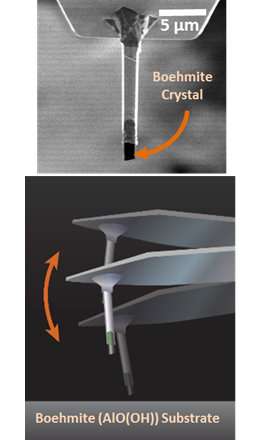Measuring small forces that lead to large effects

Forces between individual particles in slurries are responsible for their rheological behavior. Direct quantification of physical forces between mineral faces is now possible with atomic force microscopy, thanks to work at IDREAM, an Energy Frontier Research Center (EFRC) funded by DOE's Office of Science, Basic Energy Sciences.
Quantification of forces between crystal faces enables predictions of complex behaviors in colloidal systems such as self-assembly, aggregation, and rheological properties of slurries.
Forces between nanocrystals are the basis for many generic (e.g., random aggregation/assembly and rheology) and specific (e.g., oriented attachment) phenomena in slurries. Detailed knowledge of these molecular-level forces is needed to explain and predict such macroscopic phenomena. Researchers can now directly measure these forces via atomic force microscopy (AFM).
Using microfabrication methods, AFM cantilevers are modified to mount directionally oriented crystals tips. To simulate a slurry environment, the tip is placed above a well-characterized substrate in a flow-through cell where the aqueous chemistry of the system can be controlled. Changes in the force of interaction between the tip and a substrate are measured as a function of chemical conditions. This approach can be used to attach virtually any crystals to an AFM cantilever.
More information: Zhigang Wu et al. Fabrication of oriented crystals as force measurement tips via focused ion beam and microlithography methods, Surface and Interface Analysis (2017).
Provided by Pacific Northwest National Laboratory




















